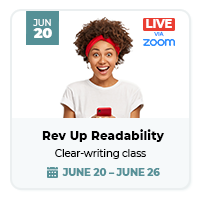How to use Flesch-Kincaid, Gunning Fog indexes
In 1946, a lawyer, author and writing consultant named Rudolph Flesch “started a revolution in journalism and business communication,” writes William Dubay, a readability consultant for Plain Language Services.

That’s the year Flesch published his first readability formula in his dissertation, “Marks of a Readable Style.” Publishers found that the formula increased readership by 40% to 60%, Dubay writes.
(It might seem weird that a lawyer would get into the readability-formulas business. But lawyers like to win cases, so they study what people can understand. Law professor emeritus Joseph Kimble compiles readability success stories, which I find helpful in selling readability.)
“People prefer to read and get information at a level below their capacity. Even a Harvard University professor prefers to get information without strain.”
— Douglas Mueller, president of the Gunning-Mueller Clear Writing Institute
There are plenty of formulas that measure the readability of text, from the Dale Chall to the Fry Readability formula. But that early Flesch test — along with the Flesch-Kincaid Grade Level and the Gunning Fog Index — are among the most frequently used in government and business.
So what’s behind these big-three readability formulas? What do they mean? And how can you use them to make your messages measurably more readable?
1. Flesch Reading Ease
The Flesch Reading Ease index is that early creation of Rudolph Flesch, author of Why Johnny Can’t Read. It computes readability based on the average number of syllables per word and the average number of words per sentence.
How to run the test. To test your copy, use Microsoft Word’s readability statistics. It will automatically run this algorithm on your message:
- Calculate the average number of words per sentence.
- Calculate the average number of syllables per word.
- Multiply the average number of syllables per word by 84.6 to get A.
- Multiply the average number of words by 1.015 to get B.
- Subtract A from B to get C.
- Subtract C from 206.835.
Goal: Aim for 60 or higher. Scores range from 0 to 100. The higher the score, the easier your copy is to read.
| Flesch Reading Ease | |||||
| Score | Level | Average number of words / sentence | Average number of syllables / word | Estimated school grade completed | Percentage of adults who can read at this level |
| 90-100 | Very easy | 8 or fewer | 1.23 or fewer | 4th | 93 |
| 80-90 | Easy | 11 | 1.31 | 5th | 91 |
| 70-80 | Fairly easy | 14 | 1.39 | 6th | 88 |
| 60-70 | Standard | 17 | 1.47 | 7th or 8th | 83 |
| 50-60 | Fairly hard | 21 | 1.55 | Some high school | 54 |
| 30-50 | Hard | 25 | 1.67 | High school or some college | 33 |
| 0-30 | Very hard | 29 or more | 1.92 or more | College | 4.5 |
| Source: Rudolph Flesch, The Art of Readable Writing, Harper (New York), 1949 | |||||
To increase your score, reduce the length of your sentences and words.
Who uses the test. Flesch’s work with the Associated Press helped bring the reading level of front-page newspaper stories from the 16th to the 11th grade.
Today, this Flesch test is one of the most widely used, most tested and most reliable readability formulas. U.S. Department of Defense, many government agencies and the state of Florida are among this Flesch test’s fans.
How long should your message be?
Would your message be twice as good if it were half as long?
Yes, the research says. The shorter your message, the more likely readers are to read it, understand it and make good decisions based on it.
 So how long is too long? What’s the right length for your piece? Your paragraphs? Your sentences? Your words?
So how long is too long? What’s the right length for your piece? Your paragraphs? Your sentences? Your words?
Find out at Rev Up Readability — our clear-writing workshop, which starts June 20.
There, you’ll use a cool (free!) tool to analyze your message for 27 readability metrics. You’ll leave with quantifiable targets, tips and techniques for measurably boosting readability.
Save up to $100 with our group discounts.
